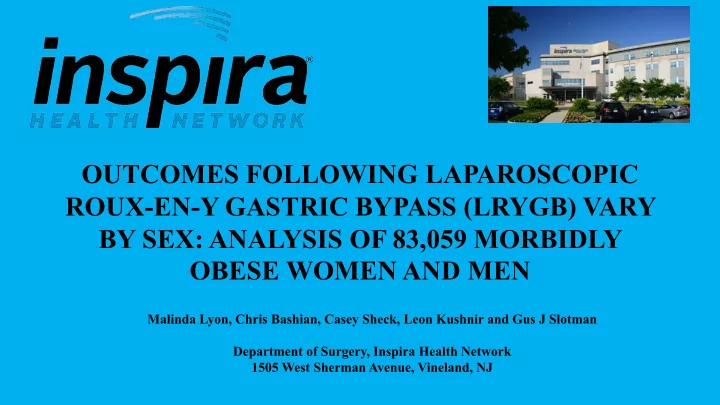

OUTCOMES FOLLOWING LAPAROSCOPIC ROUX-EN-Y GASTRIC BYPASS (LRYGB) VARY BY SEX: ANALYSIS OF 83,059 MORBIDLY OBESE WOMEN AND MEN Malinda Lyon, Chris Bashian, Casey Sheck, Leon Kushnir and Gus J Slotman Department of Surgery, Inspira Health Network 1505 West Sherman Avenue, Vineland, NJ
Disclosure Statement of Financial Interest Malinda Lyon Nothing To Disclose
In Introduction • Significant variation in the pre-operative clinical characteristics between women and men seeking LRYGB • Age, weight, BMI and the distribution of weight-related medical conditions • Whether or not the post-operative response to LRYGB for weight, BMI and the resolution or persistence of obesity co-morbidities also varies by sex is unknown
Objectiv ive • To identify statistically and clinically significant variations in long-term outcomes between women and men who underwent LRYGB
Methods • Pre-operative and follow-up data at 2, 6, 12, 18 and 24 months after surgery on 83,059 patients from the Surgical Review Corporation’s BOLD database who underwent LRYGB • Retrospective analysis of two groups: Women (n=65,325) and Men (n=17,734) • Data included age, weight, BMI, and 29 weight-related medical conditions
Methods • Statistics: • Continuous variables by ANOVA with baseline and treatment in the model • Distribution of obesity co-morbidities by a general linear model • Modified for binomial distribution to account for dichotomous variables
Results • Pre-operatively, morbidly obese patients were divided into two groups based on sex • 83,059 : 65,325 women and 17,734 men • Post-op analysis: • 2 months : 63,625 women and 17,333 men • 6 months : 36,708 women and 9,816 men • 12 months : 20,755 women and 5,390 men • 18 months : 5,472 women and 1,356 men • 24 months : 4,316 women and 1,049 men
Weig ight Loss • Male weight higher at baseline and remained higher through 24 months • Male weight loss > female at all data points • In spite of greater weight loss, male BMI remained higher through 24 months
Cardiovascular • PHT increased men>women through 12 months • CHF, PVD, HTN, and angina increased men>women through 24 months • Women were not affected more frequently than men in any cardiovascular co-morbidity
Pulmonary ry • OHS increased in men through 12 months • OSA increased in men through 24 months • Asthma increased in women through 24 months
Endocrine and and Metaboli lic • Diabetes, gout and dyslipidemia increased in men through 24 months • Only pseudotumor cerebri was increased in women
Abdominal and Hepatobiliary ry • Cholelithiasis, panniculitis, GERD and stress urinary incontinence higher in women • Increased female GERD may contribute to increased female asthma • Liver disease and abdominal hernia higher in men
Somatic • Variations by sex in back pain, musculoskeletal pain, and impaired functional status resolved after 12 months • Lower extremity edema did not vary by sex
Psychological and Behavioral • Female mental health diagnosis, depression, psychological impairment were increased • Conversely, women attended post-LRYGB support groups more often • Tobacco, alcohol, and substance abuse higher in men • Increased alcohol intake may contribute to increased male liver disease
Results • Men had 17 obesity co-morbidities greater than women • Women were higher in 9 co-morbidities
Conclusion • Women: • Persisted higher in cholelithiasis, abdominal panniculitis, GERD, stress incontinence, and in serious mental health conditions • Men: • Failed to resolve cardiopulmonary/vascular issues and metabolic derangements (diabetes, gout, dyslipidemia) • Developed abdominal hernia and were functionally impaired more than women
Conclusion • In spite of greater weight loss, at 24 months BMI was higher for men • Increased alcohol consumption may contribute to increased male liver disease
Conclusion • Outcomes following LRYGB vary significantly between men and women • Women may benefit more from LRYG than do men • This advance knowledge may facilitate optimized LRYGB management
Recommend
More recommend